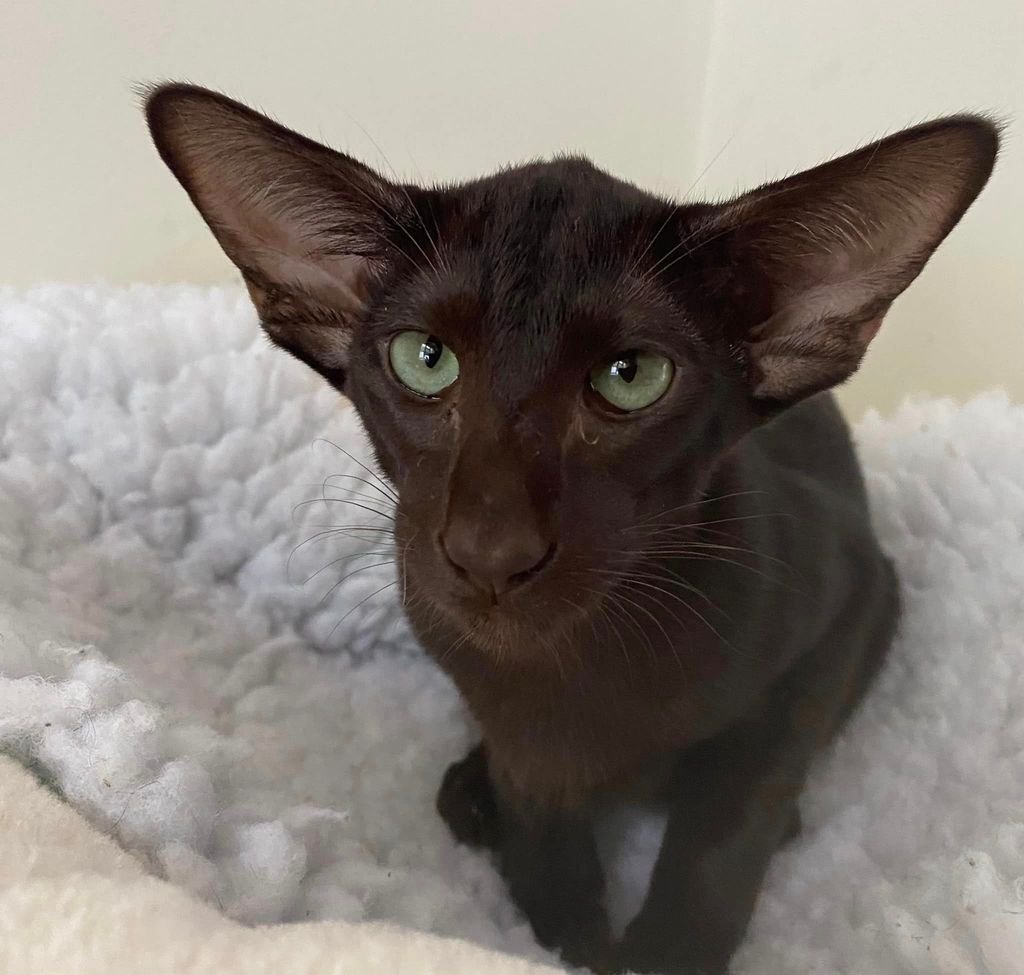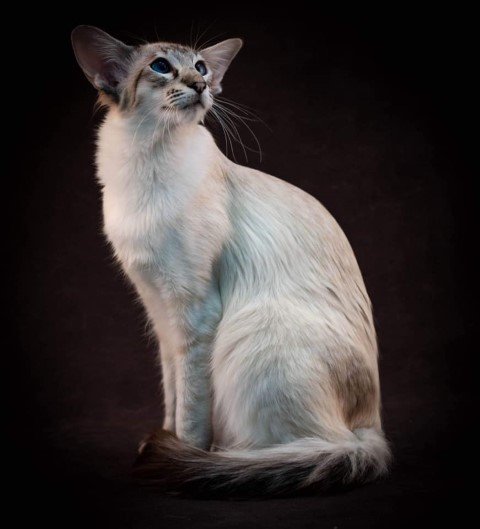This article is aimed to give new Judges to the scheme and existing judges coming in to the section from other breed lists, some guidance as to what is expected to report on so the BAC’s & JPG can “see” how you are interpreting their Standards and whether they fit the cats you judge. So I hope it is useful.
There is nothing like the “type” or “head shape” of cats in any other GCCF sections so it is vital to describe what you understand and physically see during your learning period.
What is considered in this section to be the simplest way to start writing a report, is to assess the cat as per the standard and say where the cat differs. When assessing the wedge, the overall triangular shape and the evenness of the lines is paramount in your description.
“Say what you see “

Siamese
Siamese Standard says -Head – Set on a long and slender neck the head must represent an equilateral triangle, well proportioned with good width between the ears and narrowing in perfectly straight lines to a fine muzzle and forming a balanced wedge shape with no break or pinch at the whiskers. The head should be neither round nor pointed, avoiding exaggerated type. In profile the nose should be straight, free from any stop or dip, indentation or bump and the chin should be strong with a level bite. The tip of the chin should line up with the tip of the nose in the same vertical plane. Large and wide at the base with their setting continuing the lines of the wedge. Cats should be penalised equally for ears which are set too high or too low, distorting the triangular effect.
Comment: So this cat above shows a perfectly balanced medium length wedge showing the correct width across the head between the ears, and at eye level enough to hold the correct wide based ears so they follow the lines of the wedge properly. This is not a long or a narrow wedge. So in report writing you will be able to say why it is a balanced wedge and ensure you describe the length and evenness of the lines, or not as the case may be. This cat was in fact, recently selected, by the SCJAC as their ideal type for the Standard of Points.

Oriental
Oriental Standard says- Set on a long and slender neck the head must represent an equilateral triangle, well proportioned with good width between the ears and narrowing in perfectly straight lines to a fine muzzle and forming a balanced wedge shape with no break or pinch at the whiskers. The head should be neither round nor pointed, avoiding exaggerated type. In profile the nose should be straight, free from any stop or dip, indentation or bump and the chin should be strong with a level bite. The tip of the chin should line up with the tip of the nose in the same vertical plane. Ears Large and wide at the base with their setting continuing the lines of the wedge. Cats should be penalised equally for ears which are set too high or too low, distorting the triangular effect.
Comment: This Oriental shows a slight pinch at the muzzle below the eyes, so the report must state the pinch as the lines cannot be therefore totally straight or even face on.

Balinese
Standard says -Head : Long and well proportioned, carried upon an elegant neck, with width between the ears, narrowing in perfectly straight lines to a fine muzzle, with straight profile, strong chin and level bite. Ears rather large and pricked, with width at base, set to follow the lines of the wedge. The ears may be tufted.
Comment: Because the Balinese have more fur length visibly to the head, always feel the lines and the profile and say if and where it differs from the standard.
Tips for your Reports…
- Add your name and the Show / date in a header or on every page and do number the pages. ✓
- When emailing your reports, add your name and the show /Date in the email Subject Box. ✓
When Judging
- Look at the balance if the head, does it form an equilateral triangle? If not say why you feel it doesn’t? is the head too long and narrow ? are the ears set too high or too low? Thus, throwing the head out of balance. Don’t be afraid to say what you see, if the head doesn’t conform to what you see as a balanced triangle, say why it doesn’t – if in doubt do ask!
- When looking at the wedge, let your eye look at the ear set, let the cat rest in the pen too if they are twiddling their ears about out of the pen, cats can drop their ears when afraid too so be aware of this and if needed let the cat settle in its pen before making your final decision, if you feel the ears are set too low, say so, don’t assume all Siamese follow the SOP, they don’t. If the ears are TOO low they can distort the eye shape and pull the eyes down at their outer edges thus the eyes won’t be an Oriental shape, if you feel this, say so. This way the BAC & JPG can get an understanding of how you see and interpret and this forms part of the feedback in your education.
- Length of head is important to appreciate when it’s a medium wedge or a long wedge, or even if its appears too short? Is it that the ears are oversized for the wedge? the important aspect is the overall balance.
- When describing the head face on, does it narrow to a fine muzzle in a straight line or is there a pinch ? if there is a pinch, then the wedge is not straight face on.
- In profile, is the line of the nose isn’t straight say why, is there a dip? Where is the dip, eg below the eyeline? or if a bump ? where is it. Does the nose curve downwards as in a roman nose? If so? Say so or is it that the nose at the tip rounds downwards…say what you see.
- On Eyes, ALWAYS read the individual eye colour descriptions, don’t try to inject a colour that you think it might represent, like sapphire or mediterranean blue or sea green etc, people interpret colours differently, it’s the “depth” of the eye colour and then is it “brilliant” blue. In the Orientals, again it’s the depth of green that is important and whether the colour appears to be “vivid” these are 2 different descriptions of the eye colour, they don’t mean the same thing.
- On the Body & legs & Tails, you are looking for an elegant, slender cat but with Balinese and some Oriental longhairs, especially neuters they may not be as slender boned, always feel the boning of legs as there is more fur on the longhaired varieties, and some neutered cats do appear slightly thicker boned, if that is what you see, then don’t write the cat up as elegant and slender boned, report on what you see and how it differs to the standard, even slightly. Longhairs do not have tail plumes, it is just a plume and report whether it needs more plume-like if its shorter coated.
- Section 6 breeds “mature” around 16-18 months, so they cannot be described as developmental in eye colour or points where appropriate
- Coats
- Shorthaired – Unlike other breeds where the coat texture is described as crisp, soft, silky, satiny, etc. The Siamese and Oriental Shorthair asks for the coat to be only “ finely textured” which will ensure the coat lays close to the body, it is a short coat too, so if the coat looks longer , say so, don’t assume they’re all short and finely textured. If the coat feels slightly harsh then it isn’t finely textured, sometimes the coat can feel like this also towards the base of the tail, if you feel this? Say so.
- Longhaired Orientals and Balinese – The coats are not like a long haired or even a semi longhaired cat in other sections. The coat is medium length and the texture is still finely textured, but the term silky is included in the LH breeds in S6. The important aspect is that the coat lays “flat” if it doesn’t then you need to understand why, if the coat is thicker textured or it has what appears to be a “woolly” undercoat, say so as this is undesirable, so always feel the coat and smooth where possible to feel and asses texture. Ruffs develop as the cat matures, as in other breeds, but remember these mature 16-18 months so if you have a 2 year old with little ruff don’t report it as ruff developing, just state what you see and that it could be more fuller.
- Patterns in Orientals, the descriptions in the Bi-Colour group, 01, 02 & 03 have differing requirements of white and it is required that you assess the placing and amount overall of white in your reports.
- Tabbies- always check the standard for tail rings as they differ between the 3 breeds, eg, in Siamese anything LESS than halfway up the tail is a Withholding fault, whereas in Balinese the rings MUST cover the whole tail.
To summarise, it will be easier to learn if you write the cat up in this order:
- Head & ears
- Eyes
- Body, legs, Paws & Tail
- Coat length and texture
- Points & body ( coat)
- Pattern description.

